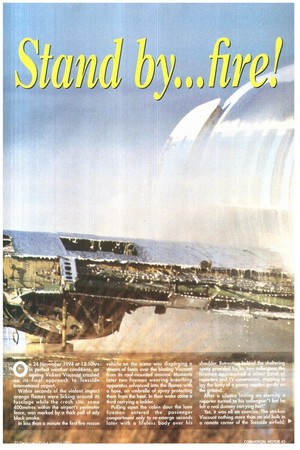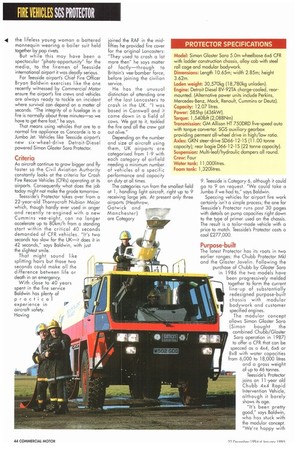n 24 November 1994 at 13:10hrs in perfect weather conditions,
Page 45

Page 46

Page 47

If you've noticed an error in this article please click here to report it so we can fix it.
an ageing Vickers Viscount crashed on its final approach to Teesside International airport.
Within seconds of the violent impact orange flames were licking around its fuselage while the crash site, some 400metres within the airport's perimeter fence, was marked by a thick pall of oily black smoke.
In less than a minute the first fire rescue vehicle on the scene was disgorging a stream of foam over the blazing Viscount from its roof-mounted monitor. Moments later two fireman wearing breathing apparatus advanced into the flames with a hose, an umbrella of spray protecting them from the heat. In their wake came a third carrying a ladder. Pulling open the cabin door the lone fireman entered the passenger compartment only to re-emerge seconds later with a lifeless body over his shoulder. Retreati the sheltering spray provided by 's two co/leagues the fireman approached a silent hand of reporters and TV cameramen, stopping to lay the 13ixly of a young woman gently on she ground.
After a silence lasting an eternity a reporter turned to his colleague:1 bet he felt a real dummy carrying her!" Yes, it was all an exercise. The stricken Viscount nothing more than an old hulk in a remote corner of the Teesside airfield;
the lifeless young woman a battered mannequin wearing a boiler suit held together by pop rivets. But while this may have been a spectacular "photo-opportunity" for the media, to the firemen of Teesside international airport it was deadly serious. For Teesside airport's Chief Fire Officer Bryan Baldwin exercises like the one recently witnessed by Commercial Motor ensure the airport's fire crews and vehicles are always ready to tackle an incident where survival can depend on a matter of seconds. "The integrity of a fuselage in a fire is normally about three minutes—so we have to get there fast," he says. That means using vehicles that are to a normal fire appliance as Concorde is to a Jumbo Jet. Vehicles like Teesside airport's new six-wheel-drive Detroit-Diesel powered Simon Gloster Sara Protector.
Criteria
As aircraft continue to grow bigger and fly faster so the Civil Aviation Authority constantly looks at the criteria for Crash Fire Rescue Vehicles (CFRs) operating at its airports. Consequently what does the job today might not make the grade tomorrow. Teesside's Protector takes over from a 22-year-old Thornycroft Nubian Major which, though hardly ever used in anger and recently re-engined with a new Cummins vee-eight, can no longer accelerate up to 80km/h from a standing start within the critical 40 seconds demanded of CFR vehicles. "It's two seconds too slow for the UK—it does it in 42 seconds," says Baldwin, with just the slightest smile. That might sound like splitting hairs but those two seconds could make all the difference between life or death in an emergency. With close to 40 years spent in the fire service Baldwin has plenty of practical experience in aircraft safety.
Having *pined the RAF in the midfifties he provided fire cover for the original Lancasters: "They used to crash a lot more then" he says matter of factly—through to Britain's vee-bomber force, before joining the civilian service.
He has the unusual distinction of attending one of the last Lancasters to crash in the UK. "I was based in Cornwall and it came down in a field of cows. We got to it, tackled the Fire and allthe crew got out alive."
Depending on the number and size of aircraft using them, UK airports are categorised from 1-9 with each category of airfield needing a minimum number of vehicles of a specific performance and capacity on duty at all times. The categories run from the smallest field at 1, handling light aircraft, right up to 9 receiving large jets. At present only three airports (Heathrow,
Gatwick and pt7wlem,
Manchester) are Category
9. Teesside is Category 6, although it could go to 9 on request. "We could take a Jumbo if we had to," says Baldwin.
Speccing vehicles for airport fire work certainly isn't a simple process; the one for Teesside's Protector runs past 30 pages with details on pump capacities right clown to the type of primer used on the chassis. The result is a tailor-made vehicle with a price to match. Teesside's Protector costs a cool £277,000.
Purpose-built
The latest Protector has its roots in two earlier ranges: the Chubb Protector MkI and the Gloster Javelin. Following the purchase of Chubb by Gloster Saro in 1 986 the two models have been progressively melded together to form the current line-up of substantially redesigned purpose-built chassis with modular bodywork and customer specified engines. The modular concept allows Simon Gloster Sara (Simon bought the combined Chubb/Gloster Saro operation in 1987) to offer a CFR that can be specced as a 4x4, 6x6 or 8x8 with water capacities From 6,000 to 18,000 litres and a gross weight of up to 46 tonnes. Teesside's Protector joins an 11-year old Chubb 4x4 Rapid Intervention Vehicle, although it barely shows its age, "It's been pretty good," says Baldwin, who has stuck with the modular concept. "We're happy with the Protector and Simon Gloster Saro is very competitive when it comes to pricing." SGS has not much competition. The Hucclecote-based manufacturer takes around 80% of the UK CFR and RIV market ahead of main rival Carmichael although Continental manufacturers, like Rosenbauer are beginning to eye the UK up. As vehicle performance has improved so too has crew comfort. The days when firemen sat for hours on end in draughty trucks has long since gone, says Baldwin.
Flammable
"Aircraft are a lot safer today, in the old days we were dealing with avgas which was highly flammable. Today jet fuel is paraffin, with a much higher flash point. What's more pilots nowadays are likely to be more aware of anything going wrong. If there is a problem they have some warning. At the first hint of trouble they'll press the bell and we'll be there."
That means the vehicles must still be ready to roll at a moment's notice. To ensure firsttime starting, every time, the batteries on the Protector are constantly trickle-charged by quick-release "snatch" plugs while an electrically powered water heater keeps the engine coolant warm in the winter.
On top of that the vehicle is put through its paces at every opportunity as Baldwin explains: "It's inspected twice a day by the crews. The first shift comes on at 06:00 and the second shift at 13:00hrs. It's given a run up and the crew take it through a full checklist. If there's a defect they have to sign it off immediately with the MT dept." A special vehicle like the Protector requires specially trained crew.
"All my people are HGV holders—that's a prerequesite, with 50% of them being local authority retained while the rest come straight from the RAF fire service," says Baldwin. "They get constant driving experience—and one hour in every eight is devoted to training." In addition to the Protector being required to get to any part of the aircraft movement area inside the perimeter fence within three minutes— according to Baldwin it can do it in two minutes—Teesside's fire team also has a responsibility for covering an overall area of some three nautical miles around the field. As a result its awesome off-road capability could be called on at any time. As the Protector's 585hp 8V-92TA Iwostroke is fired up you're left in no doubt that this is a vehicle with a real mission. Access into the cab is simple and easy for fireman in full gear in a hurry. The Allison five-speed auto box quickly feeds in the power and the acceleration is amazing. Running up to 80km/h with a GVVV of just over 30 tonnes the Protector stops the clock within 35 seconds. By way of comparison the Fastest eight-legger tested to date by CM—the 360hp &culla PI 13-360—does it in 48 seconds.
The roof-mounted monitor discharges foam at a phenomenal rate—up to 4,5001itres/min. At that rate the Protector will have exhausted its foam spreading capacity in just two minutes! But watch it in action and you'll see just how much foam is produced within 120 seconds.
During its lifetime with Teesside Airport—Baldwin says he'll be disappointed if he has to replace it for at least 15 years— the Protector will be lucky to clock up more than 5,000 miles. Most of its time will be spent sitting in the fire station waiting for an emergency call. Let's hope that call will never come.
by Brian Weatherley




















































































































